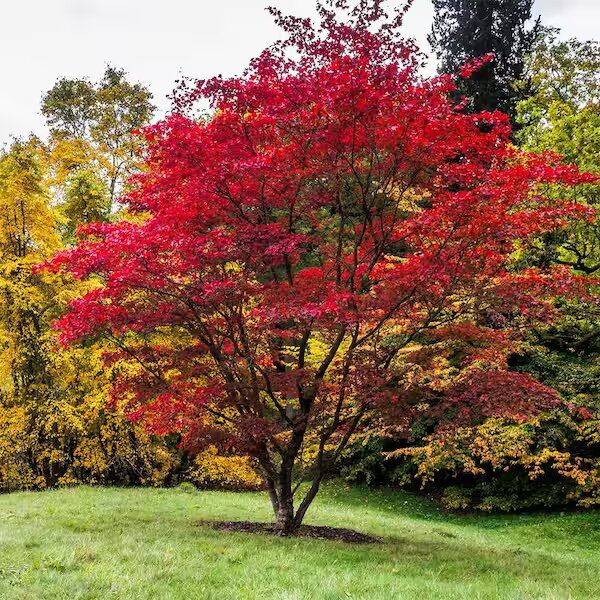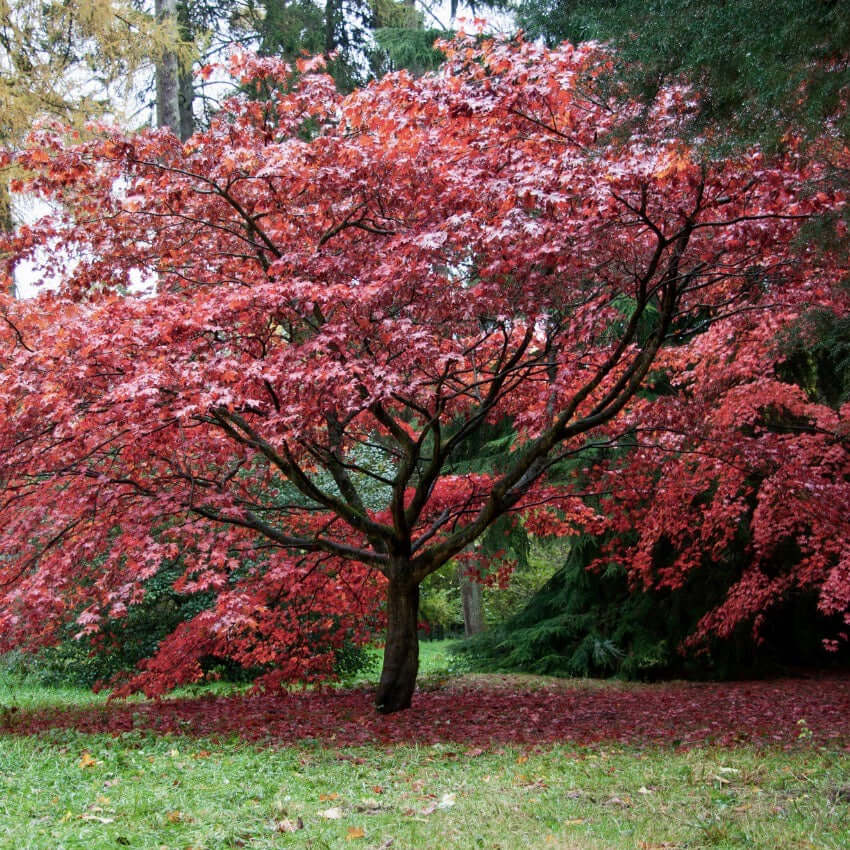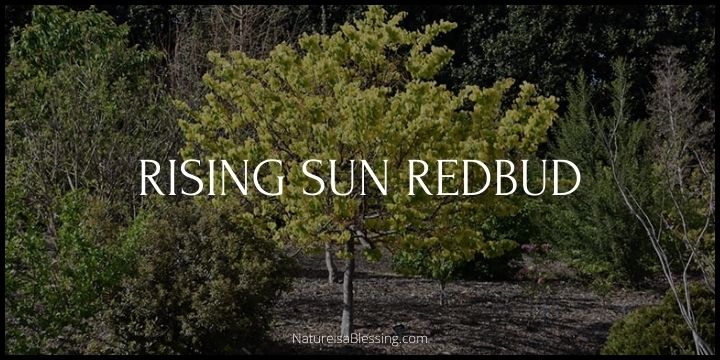Bloodgood Japanese Maple: How to Plant, Grow & Care

What is Bloodgood Japanese Maple?
The Bloodgood Japanese Maple (Acer palmatum ‘Bloodgood’) is a popular ornamental tree known for its striking aesthetics and hardiness. This deciduous tree is part of the Sapindaceae family and belongs to the Acer genus.
One of the most notable characteristics of the Bloodgood Japanese Maple is its beautiful purplish-red leaves that persist throughout the growing season, providing vibrant color in landscapes. The leaves turn even more brilliant in the fall, creating a stunning autumn display.
This tree has a mature height and width of about 15-20 feet. It thrives in full sun to part shade and prefers well-drained, sandy or clay soil with a pH that is acidic to neutral (pH 5.5 – 7.5). It blooms in spring, showing small red flowers before leafing out.
Despite its exotic appearance, the Bloodgood Japanese Maple is hardy and can tolerate varying climatic conditions. It’s suitable for USDA Hardiness Zones 5-8 and shows moderate drought tolerance. Maintenance is relatively low, primarily involving pruning in late winter or early spring.
The native area of this tree spans several East Asian countries, including Japan, Korea, and China. In addition to its aesthetic appeal, the Bloodgood Japanese Maple is also valued for its attractive, smooth gray bark.
Quick Facts About Bloodgood Japanese Maple
| Fact | Description |
|---|---|
| Common Name | Bloodgood Japanese Maple |
| Botanical Name | Acer palmatum ‘Bloodgood’ |
| Family | Sapindaceae |
| Plant Type | Deciduous tree |
| Genus | Acer |
| Mature Height | 15-20 feet |
| Mature Width | 15-20 feet |
| Sun Exposure | Full sun to part shade |
| Soil Type | Well-drained, sandy or clay soil |
| Soil pH | Acidic to neutral (pH 5.5 – 7.5) |
| Soil Drainage | Well-draining |
| Bloom Time | Spring |
| Hardiness Zones | USDA 5-8 |
| Maintenance | Low; prune in late winter or early spring |
| Water Needs | Moderate; more in extreme heat/drought |
| Native Area | Japan, Korea, China |
| Drought Tolerance | Moderate |
| Characteristics | Notable for its beautiful purplish-red leaves throughout the growing season, especially in fall; displays attractive, smooth gray bark and small red flowers before leafing out in spring. |
How to Care for Bloodgood Japanese Maple
Bloodgood Japanese Maples prefer a location with full sun to partial shade. They can tolerate a wide range of soil types, including clay, loam, and sandy soils, but they prefer well-drained, slightly acidic soil. The planting site should be sheltered from harsh winds which can dry out the leaves.
Planting Tips
- Timing: The best time to plant this tree is in late winter or early spring before the buds begin to swell.
- Hole size: Dig a hole twice as wide as the root ball and just as deep.
- Positioning: Place the tree in the hole, ensuring that the top of the root ball is level with the surrounding ground.
- Backfill: Backfill the hole with the original soil mixed with organic compost.
- Watering: Thoroughly water after planting to settle the soil.
Seasonal Care
| Season | Care |
|---|---|
| Spring | This is the best time to fertilize with a slow-release, granular fertilizer. It’s also the ideal time to prune any dead or crossing branches, always making sure to sterilize your pruning tools before and after use. |
| Summer | In hot climates, ensure the tree has adequate water, especially during dry spells. Mulch around the base to retain moisture and keep the roots cool. |
| Autumn | The tree will naturally shed its leaves. Rake and compost the leaves to prevent any potential disease spread. |
| Winter | No specific care is needed. However, in colder climates, consider wrapping young trees to protect them from harsh winter winds. |
Watering and Fertilizing
Watering should be deep and infrequent, aiming to keep the soil consistently moist but not waterlogged. Young trees may require watering once a week, while established trees can be watered less frequently.
Fertilize once a year in early spring with a slow-release fertilizer designed for acid-loving plants. Avoid high-nitrogen fertilizers as they can lead to excessive leaf growth at the expense of root development.
Pruning and Disease Prevention
Pruning should be done in late winter or early spring before new growth starts. Remove any dead, diseased, or crossing branches.
Prevent disease by ensuring good air circulation around the tree and regularly cleaning up fallen leaves. If you notice any signs of disease such as discolored leaves or unusual growths, consult with a local extension service or arborist.
Common Problems
Bloodgood Japanese Maples can suffer from leaf scorch in hot, dry conditions. This can be prevented by providing adequate water during dry spells and mulching to retain soil moisture.
Verticillium wilt is a potential disease that can affect these trees. Prevention is the best approach—ensure the planting site is well-drained and avoid overwatering.
Additional Caring Tips
Remember, Bloodgood Japanese Maples are slow-growing trees that can take several years to reach their mature size. Be patient and provide consistent care, and you’ll be rewarded with a stunning focal point for your landscape.
The key to successful Bloodgood Japanese Maple care is balance—too much or too little of anything (sun, water, nutrients) can lead to problems. Always observe your tree carefully and adjust your care routine as needed.
How big does a Bloodgood Japanese maple tree get?

A Bloodgood Japanese Maple tree, or Acer palmatum ‘Bloodgood’, is known for its relatively fast growth and can reach a mature size of between 15-20 feet tall and wide in optimal conditions.
It has a similar spread at maturity, making it a notable feature in many landscapes due to its size and vibrant leaf color.
However, the ultimate size of the tree can vary based on environmental factors and care practices. It can be as short as 12 feet or grow up to 25 feet tall. The tree can be pruned to maintain a shorter height if preferred.
What are the pros and cons of Bloodgood Japanese maple?
Benefits:
- Aesthetic Appeal: The tree’s purplish-red leaves are beautiful throughout the growing season and turn even more vibrant in the fall. Its attractive, smooth gray bark and small red flowers also add to its visual appeal.
- Hardiness: It’s suitable for USDA Hardiness Zones 5-8, meaning it can withstand cold winters.
- Maintenance: The tree requires relatively low maintenance. Pruning is only needed in late winter or early spring.
- Drought Tolerance: It has moderate drought tolerance, making it a suitable choice for areas prone to dry conditions.
- Size: With a mature height and width of about 15-20 feet, it can be a standout feature in a landscape without becoming overly large.
Drawbacks:
- Sun Exposure: While the tree can tolerate full sun, in hotter climates, its leaves may scorch in extreme heat, so it prefers part shade in these regions.
- Soil Requirements: It prefers well-drained, sandy, or clay soil with a pH that is acidic to neutral (pH 5.5 – 7.5). If the soil doesn’t meet these conditions, the tree may not thrive.
- Water Needs: The tree requires moderate water, which increases in extreme heat or drought conditions.
- Pest and Disease Susceptibility: Like many maple varieties, it can be susceptible to pests such as aphids and scale, and diseases like verticillium wilt.
The 9 Types of Japanese Maples
Japanese Maples, scientifically known as Acer palmatum, come in a wide range of cultivars, each with its distinct characteristics.
- Bloodgood Japanese Maple (Acer palmatum ‘Bloodgood’): Known for its deep purplish-red leaves that turn vibrant crimson in the fall. It’s one of the larger and hardier cultivars, growing up to 15-20 feet tall.
- Coral Bark Japanese Maple (Acer palmatum ‘Sango Kaku’): This variety is admired for its coral-red bark and yellow to lime green foliage which turns golden in the fall.
- Laceleaf Japanese Maple (Acer palmatum var. dissectum): Known for its delicate, lacy foliage with finely dissected leaves. It usually has a weeping form and comes in many colors, including red and green.
- Emperor I Japanese Maple (Acer palmatum ‘Wolff’): Similar to the ‘Bloodgood’, this tree has dark red foliage that resists burning in full sun and turns bright scarlet in the fall.
- Shishigashira Japanese Maple (Acer palmatum ‘Shishigashira’): Also known as the “lion’s head maple” due to its unique crinkled foliage. It has green leaves that turn orange-red in the fall.
- Osakazuki Japanese Maple (Acer palmatum ‘Osakazuki’): Renowned for its brilliant fall color, this tree has large green leaves that turn fiery crimson in the autumn.
- Seiryu Japanese Maple (Acer palmatum ‘Seiryu’): The only upright variety of laceleaf Japanese maples, it has light green leaves that turn vibrant shades of gold, orange, and red in the fall.
- Butterfly Japanese Maple (Acer palmatum ‘Butterfly’): A small, slow-growing variety with variegated leaves that are grey-green with cream and pink margins.
- Crimson Queen Japanese Maple (Acer palmatum var. dissectum ‘Crimson Queen’): This is a weeping form of Japanese maple with deep red-purple foliage that turns bright red in the fall.
What is the difference between Japanese maple and Bloodgood Japanese maple?
The term “Japanese Maple” is a general name that applies to a wide variety of Acer palmatum trees, which are native to Japan, China, and Korea. There are hundreds of different cultivars of this maple species, each with its unique features, and the ‘Bloodgood’ Japanese Maple is one of these cultivars.
Here’s how the ‘Bloodgood’ stands out from other Japanese maples:
| Feature | Japanese Maple (General) | Bloodgood Japanese Maple |
|---|---|---|
| Leaf Color | Varies by cultivar, can be green, red, or variegated. | Deep purplish-red leaves that retain color throughout the summer. |
| Fall Color | Varies by cultivar. Can range from yellow to orange to red. | Turns a vibrant crimson red. |
| Size | Size varies greatly among cultivars, with some as small as 4 feet and others reaching up to 25 feet. | Typically grows to a mature size of 15-20 feet tall and wide. |
| Hardiness | Hardiness varies by cultivar. Most are suitable for USDA Hardiness Zones 5-9. | Suitable for USDA Hardiness Zones 5-8. More hardy than some other varieties. |
| Growth Rate | Growth rate varies by cultivar. Many are slow-growing. | Relatively fast growth rate compared to some other Japanese maple varieties. |
| Popularity | Hundreds of different cultivars, each with unique features. | One of the most popular Japanese maple cultivars due to its striking aesthetics and hardiness. |
- Leaf Color: While many Japanese maples have red or green leaves, the ‘Bloodgood’ is especially known for its deep purplish-red leaves that retain their color throughout the summer, even in full sun, which is not common among other varieties.
- Fall Color: The ‘Bloodgood’ maple turns a vibrant crimson red in the fall, which can be more intense than many other Japanese maple varieties.
- Size: ‘Bloodgood’ is one of the larger Japanese maple cultivars. It can grow up to 15-20 feet tall and wide, making it bigger than many other Japanese maples, which tend to be smaller and more shrub-like.
- Hardiness: ‘Bloodgood’ is one of the hardier Japanese maple cultivars. It’s suitable for USDA Hardiness Zones 5-8, meaning it can withstand cold winters better than some other varieties.
- Growth Rate: ‘Bloodgood’ has a relatively fast growth rate compared to some other Japanese maple varieties, which are often slow growers.
- Popularity: ‘Bloodgood’ is one of the most popular Japanese maple cultivars due to its striking aesthetics and hardiness.
In contrast, other Japanese maple varieties may have different leaf colors, sizes, growth rates, and hardiness zones. For example, the ‘Coral Bark’ Japanese Maple is known for its bright red bark, and the ‘Shishigashira’ has curled green leaves.
Does Bloodgood Japanese maple stay red?

The ‘Bloodgood’ Japanese Maple is known for its deep purplish-red leaves, but whether it retains this color throughout the year can depend on several factors.
Generally, ‘Bloodgood’ Japanese Maples have stunning, bold red foliage across three seasons. However, their leaf color can vary based on sunlight exposure and heat levels. In a location that receives morning sun and afternoon shade, ‘Bloodgood’ will usually retain its reddish color but may turn green-bronze in mid-summer with more sunshine and heat.
Furthermore, in hotter summer climates with a lot of direct sun, the tree might turn green. As the seasons change, this cultivar’s leaves can also transition from red to a bronze-yellow-green color combination during the summer due to strong sun and high temperatures.
In summary, while the ‘Bloodgood’ Japanese Maple is famed for its red foliage, environmental conditions such as sunlight exposure and temperature can affect its color retention.
Can Bloodgood Japanese maple get too much sun?
Yes, ‘Bloodgood’ Japanese Maple trees can get too much sun. While they can tolerate full sun, they prefer some shade, especially in the afternoon when the sun is most intense. Too much direct sunlight can cause leaf scorch, where the leaves turn brown around the edges and curl up.
In hot climates or during particularly hot summers, a ‘Bloodgood’ Japanese Maple placed in full sun may experience stress, leading to changes in leaf color from red to green or even bronzed appearances. It’s also possible for the leaves to become sunburned, which can cause them to wilt, develop brown spots, or even die off.
Therefore, it’s generally recommended to plant ‘Bloodgood’ Japanese Maples in a location that gets partial shade, especially in the afternoon. They also need well-drained soil and regular watering, especially during dry periods, to help prevent leaf scorch.
Which is better: Bloodgood or red leaf Japanese maple?
The choice between a Bloodgood and Red Leaf Japanese Maple largely depends on your specific needs and preferences as both have their unique characteristics.
| Bloodgood Japanese Maple | Red Leaf (Emperor) Japanese Maple | |
|---|---|---|
| Color | Purplish-red leaves that turn vibrant crimson in fall | Dark red leaves that retain color in summer |
| Size | Grows 15-20 feet tall | Slightly larger than Bloodgood, can reach 20 feet or more |
| Growth Rate | Moderate | Slightly faster than Bloodgood |
| Weather Resistance | Hardy, but may struggle in extreme heat | Better at handling extreme weather conditions |
| Availability | Widely grown and easily available | Less common than Bloodgood |
| Sun Tolerance | Can tolerate full sun, but prefers partial shade | Can tolerate full sun, but prefers partial shade |
Bloodgood Japanese Maple:
A very reliable and predictable variety, known for its deep purplish-red leaves that turn vibrant crimson in the fall. It’s one of the more hardy cultivars, growing up to 15-20 feet tall. It’s also widely grown and well-known, making it a popular choice for many gardeners.
Red Leaf Japanese Maple (also known as Emperor Japanese Maple):
Compared to the Bloodgood, the Emperor Japanese Maple grows slightly faster and can handle extreme weather conditions better. In spring and summer, the Emperor’s foliage is a dark-red color, which tends to retain its hue even in the heat of summer.
In terms of aesthetics, the Bloodgood tends to have a more purplish-red leaf, while the Emperor has a darker, more consistent red leaf. The “better” choice will depend on which color you prefer, your climate, and your patience for growth.
Where to buy Bloodgood Japanese Maple?
- Mr. Maple
- Fast Growing Trees
- Amazon
- The Tree Center
- Moon Valley Nurseries
- Wilson Bros Gardens
- Home Depot
- Walmart
- Calloway’s Nursery
Note: availability may vary based on your location and the time of year. It’s always a good idea to check with each retailer for current stock and pricing.
Frequently Asked Questions
1. How fast does Bloodgood Japanese Maple grow?
The Bloodgood Japanese Maple is known for its moderate growth rate. Generally, it grows between 1 and 2 feet per year, depending on its growing conditions. Enhanced watering and a bit of fertilizer can potentially boost its growth to around 2 feet per year.
The tree tends to grow rapidly in its initial years, doubling in size after a few years. After about a decade, it can reach a height of about 10 feet and a width of 5 feet.
Ultimately, in its maturity, the Bloodgood Japanese Maple will reach between 15 to 20 feet tall.
2. How to plant Bloodgood Japanese Maple?
Planting a Bloodgood Japanese Maple requires careful preparation and attention to detail. Start by selecting a location that offers full sun to partial shade and is protected from strong winds. The soil should be well-draining, slightly acidic, and rich in organic matter.
Dig a hole twice as wide and just as deep as the root ball of your tree. Place your tree in the hole, ensuring that the top of the root ball is level with the ground surface. Backfill the hole with a mixture of original soil and compost, then water thoroughly to settle the soil around the roots.
After planting, apply a layer of mulch around the base of the tree to help retain moisture and regulate soil temperature.
3. How Far From The House Should I Plant Bloodgood Japanese Maple?
Bloodgood Japanese Maple trees can grow to be 15-20 feet wide and 15-20 feet tall. Therefore, it’s recommended that you plant this tree at least 15-20 feet away from your house. This will allow the tree enough room to mature without interfering with the structure of your home.
It also helps to prevent any root damage to the foundations or underground pipes. However, if you plan on maintaining the tree at a smaller size through regular pruning, it could be planted closer. Always consider the mature size of the tree when deciding on planting distance.
4. How hardy is Bloodgood Japanese Maple?
The Bloodgood Japanese Maple is considered quite hardy and robust. It is capable of growing in USDA Hardiness Zones 5-9, which covers most of the country except for the extremely hot and cold regions.
This tree is low maintenance, disease, and pest-resistant, making it a popular choice among gardeners.
However, while it’s one of the hardiest Japanese maples, it does not tolerate harsh weather conditions well, hence it thrives best in temperate climates with warm, mild year-round temperatures.
Also read:





